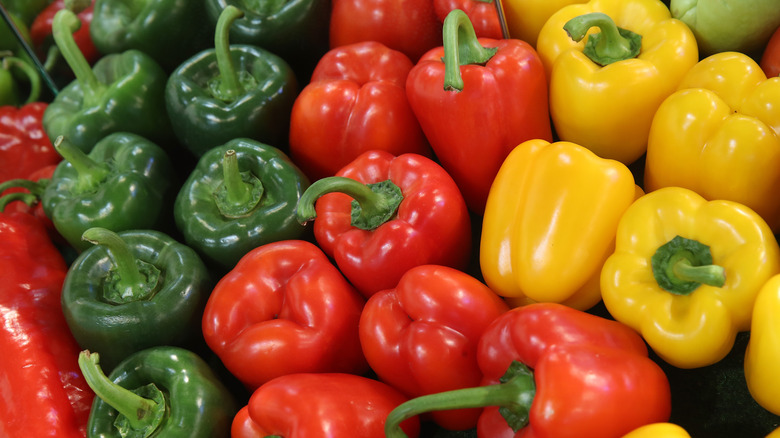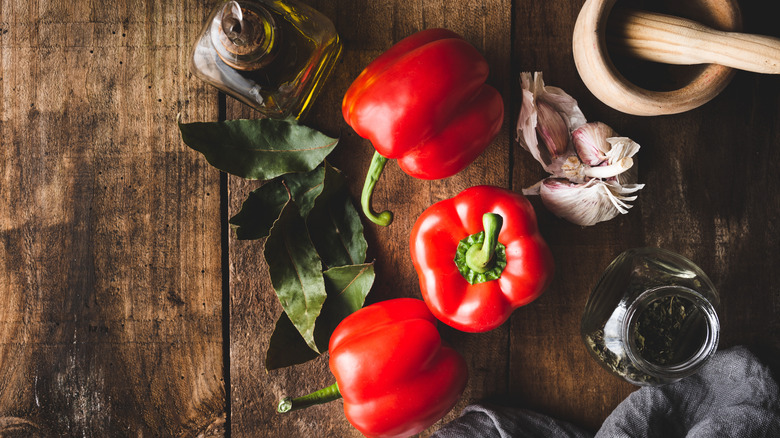What's The Difference Between Green, Yellow, And Red Bell Peppers?
If you're a picky eater, you probably have a list of foods you like to eat and foods you just can't stand. And if you dislike bitter foods, green peppers just might be at the top of the list.
A green pepper's bitter, earthy, slightly grassy flavor can be an acquired taste. Luckily, there are plenty of other peppers, including red, yellow, and orange varieties, that you can add to your diet. However, you might be surprised to learn that green, yellow, and red peppers are all the same fruit — that's right. Bell peppers, which grow from the flower of the plant and have their seeds on the inside, are technically a fruit. However, they're classified as a vegetable in the culinary world thanks to their tough, crunchy texture and savory taste (via EUFIC).
Bell peppers become different colors during different stages of development. Green identifies the peppers' unripe version and is the color of the bell pepper that first appears on the plant, while red peppers are the most mature varieties. Peppers take on yellow and orange hues as they move through their maturity. Although they all come from the same plant, the different stages of ripeness give each version a distinct flavor and color.
Different colored bell peppers have different flavor profiles
Bell peppers are versatile culinary vegetables that make a great addition to a variety of recipes. Fresh bell peppers are commonly added to sandwiches and salads for a crispy, refreshing crunch, but they are also great on the grill, in a saute, or stuffed with meat, rice, and spices for a filling and satisfying meal. But which variety you use in your recipe depends on what flavor profile you are going for.
Green peppers are famously bitter and deliver a grassy, vegetal flavor that can be a great complement to sweet or rich dishes, according to Ask The Food Geek. On the other hand, red peppers are sweet, juicy, and citrusy. Yellow and orange peppers also taste somewhat fruity and sweet, although they are less sweet than ripe red peppers.
However, red, yellow, orange, and green are not the only colors that bell peppers can come in. Although it is less common, bell peppers can also come in shades of brown, white, and even purple, due to the heart-healthy, antioxidant-rich anthocyanins that give the external shell of the bell pepper its rich distinctive hue, according to Ark Foods.
Red peppers contain the most nutrients
While these color variations derive from the same vegetable, that doesn't mean they are all nutritional equals. Because they have spent the longest time on the vine, red peppers actually pack the most nutrients into each serving, according to Web MD. They also contain an antioxidant known as lycopene, found in brightly pigmented red vegetables like tomatoes, which has been shown to help reduce one's risk of developing cancer (via Pepper Scale). Red bell peppers also contain high amounts of beta-carotene, which helps keep eyes healthy, and important minerals like calcium, iron, and manganese.
However, all bell pepper varieties are a great source of potassium, fiber, folic acid, Vitamin A, and immunity-boosting Vitamin C. In fact, adding any type of bell pepper to your diet has been shown to help reduce the risk of developing heart disease, cancer, high blood pressure, and type 2 diabetes (via Web MD). So no matter if you prefer the sweetness of a ripe red pepper or enjoy the earthy crunch of a green one, you can't go wrong adding this colorful, nutritious, and versatile plant to your diet.


